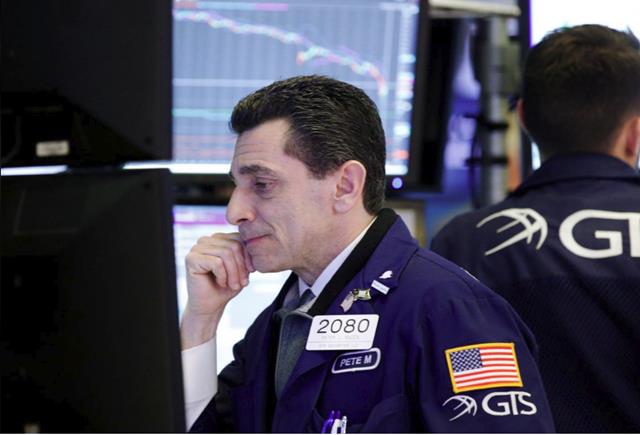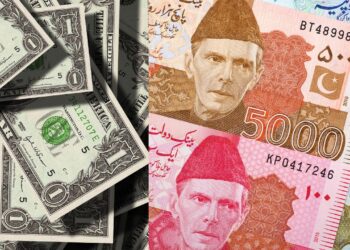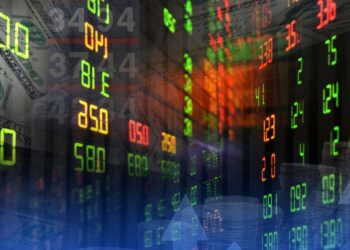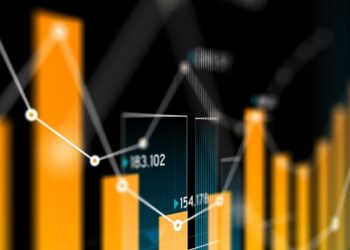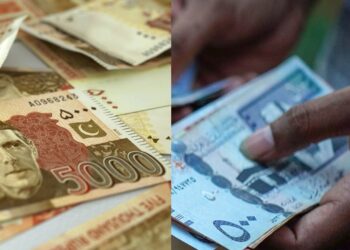Europe’s main bourses were down around 2.5 percent and Wall Street futures pointed to more losses too as “fear gauges” of market volatility leapt to their highest level since a surprise devaluation of China’s currency in 2015.
The flashing warning signs left investors with little option but to seek traditional refuges such as gold and the dollar. Benchmark government bonds — ironically one of the initial triggers for the selloff — also gained.
Commodities remained gloomy too, with oil and industrial metals all tumbling backwards as the year’s stellar start for risk assets rapidly soured.
“Playtime is officially over, kids,” analysts at Rabobank said. “Rising volatility painfully reminds some investors that one-way bets don’t exist.”
The equity market selloff had been viewed by some as a healthy correction after a rapid run up over the last year, but as it snowballed through Asia and Europe and looked to be on its way back to Wall Street, nerves were starting to fray.
Europe’s drop sent the region’s STOXX 600 to its lowest level in six months while the losses for MSCI’s widely tracked 47-country world index broke $4 trillion as its drop since Friday neared 8 percent.
Wall Street’s Dow Jones and S&P 500 benchmarks had slumped 4.6 percent and 4.1 percent on Monday, their biggest drops since August 2011. It was also the Dow’s biggest fall on a pure points basis of all-time and put it in the red for 2018.
There was intense trading activity, with the average daily volume on Europe’s blue-chip STOXX 50 already easily surpassed by the middle of the session.
The euro STOXX volatility index, Europe’s main gauge of market anxiety, saw its biggest spike since the Sept. 11, 2001 attacks on the United States. The better known Wall Street VIX, screamed above the 50 mark.
“This is not the end of the bull market, but it is the end of the super low volatility regime,” said David Lafferty, Chief Market Strategist at Natixis Investment Managers.
“The last two days of trading has thrown a giant bucket of cold water on the short volatility trade and I think we’re now in for prolonged period of elevated volatility generally.”
GOLDILOCKS VS THE BEARS
“Since last autumn, investors had been betting on the ‘Goldilocks’ economy — solid economic expansion, improving corporate earnings and stable inflation. But the tide seems to have changed,” said Norihiro Fujito, senior investment strategist at Mitsubishi UFJ Morgan Stanley Securities.
MSCI’s broadest index of Asia-Pacific shares outside Japan slid 3.4 percent overnight.
A trader reacts as he watches his screens on the floor of the New York Stock Exchange in New York, U.S., February 5, 2018. REUTERS/Brendan McDermid
Taiwan’s main index lost 5.0 percent, its biggest slump since 2011, Hong Kong’s Hang Seng Index dropped 4.2 percent and Japan’s Nikkei dived 4.7 percent, its worst fall since November 2016, to four-month lows.
The original trigger for the sell-off was a sharp rise in U.S. bond yields late last week after data showed U.S. wages increasing at the fastest pace since 2009. That raised the alarm about higher inflation and, with it, potentially higher interest rates.
That could be painful for markets that have been propped up by central banks’ stimulus for many years.
The 10-year U.S. Treasuries yield rose to as high as 2.885 percent on Monday, its highest in four years.
But the massive fall in share prices prompted an about-turn, which sent it back to as low as 2.662 percent. German Bunds, Europe’s benchmark, saw yields fall 6 basis points, their biggest drop in over two months.
“Ten-year treasuries at four-year highs — does this herald the start of a bond bear market? Or are we simply returning to a more ‘normal’ cycle of higher yields and higher interest rates?” said Graham Bishop, Investment Director at Heartwood Investment Management.
REDUCING RISK
The CBOE Volatility index, the closely followed measure of expected near-term U.S. stock market volatility, jumped over 30 points to 50, its highest level since August 2015.
That left some popular exchange-traded products that investors use to benefit from calm market conditions facing potential liquidation.
Keen to avoid further risk, investors were closing their positions in other assets, including FX markets, where a popular trade has been to sell the dollar against the euro and other currencies seen as benefiting from higher future interest rates.
The euro had been clawing back ground but was suddenly swiped back to $1.2353 as U.S. traders began to buy up the dollar.
That left it not far from last week’s low of $1.2335, a break of which could usher in a further correction after its rally to a three-year high of $1.2538 by late last month.
Oil prices continued to droop too, with international benchmark Brent hitting a one-month low, before levelling off at $66.90 per barrel, down 1 percent on the day.
U.S. crude futures were trading down 1.3 percent at $63.33 per barrel, while gold nudged up for a fourth day in the last five, to $1,340 per ounce.
“I think this is a healthy, albeit rather vicious correction (in equity markets) and we may see more over the next week, but on the whole I really wouldn’t panic,” said broker Marex Spectron’s head of precious metals, David Govett.
“As such, I don’t think gold will go a lot higher.”
Additional reporting by Hideyuki Sano in Tokyo and Helen Reid in London; Editing by Catherine Evans


